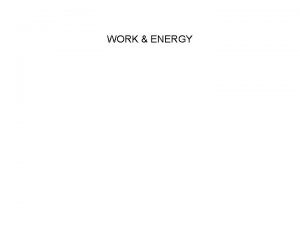WORK ENERGY Class Activities Work Energy 2 47









- Slides: 9

WORK & ENERGY

Class Activities: Work + Energy

2. 47 Three identical charges +q sit on an equilateral triangle. What would be the final KE of the top charge if you released it (keeping the other two fixed) A) C) E) other B) D)

2. 48 Three identical charges +q sit on an equilateral triangle. What would be the final KE of the top charge if you released all three? A) C) E) other B) D)

Does system energy “superpose”? That is, if you have one system of charges with total stored energy W 1, and a second charge distribution with W 2… if you superpose these charge distributions, is the total energy of the new system simply W 1+W 2? A) Yes B) No


During the last class we found that the energy stored in a particular arrangement of charges can be expressed as: Wsys = ½ ∑ qi∙Vi(ri) or as: Wsys = ½ ∫ E 2 dτ’ Why can the first expression be negative, but the second one is positive (or zero)? A – We did a mistake in the derivation. B –The second expression also contains the energy required to make the charges. C – Energy is always a positive quantity, which we expressed by squaring the E-field. D – Must be something else. E – How should I know. I don’t do the reading assignments.

r Two charges, +q and –q, are a distance r apart. As the charges are slowly moved together, the total field energy A) increases B) decreases C) remains constant (Come up with two different reasons for your answer. )

+Q -Q A parallel-plate capacitor has +Q on one plate, -Q on the other. The plates are isolated so the charge Q cannot change. As the plates are pulled apart, the total electrostatic energy stored in the capacitor A) increases B) decreases C) remains constant. (Come up with two different reasons for your answer. )
 Work, power and energy activities
Work, power and energy activities The statement of cash flows helps users
The statement of cash flows helps users Indoor sports and outdoor sports
Indoor sports and outdoor sports Support activities and primary activities
Support activities and primary activities Primary activities and tertiary activities
Primary activities and tertiary activities Work energy theorem for a variable force class 11
Work energy theorem for a variable force class 11 Physics 03-06 impulse and momentum answer key
Physics 03-06 impulse and momentum answer key Chapter 4 work and energy section 1 work and machines
Chapter 4 work and energy section 1 work and machines Work and energy section 2 describing energy
Work and energy section 2 describing energy Organize and complete daily work activities
Organize and complete daily work activities
















